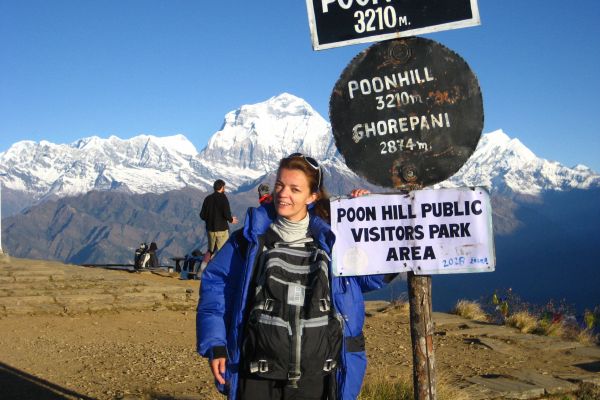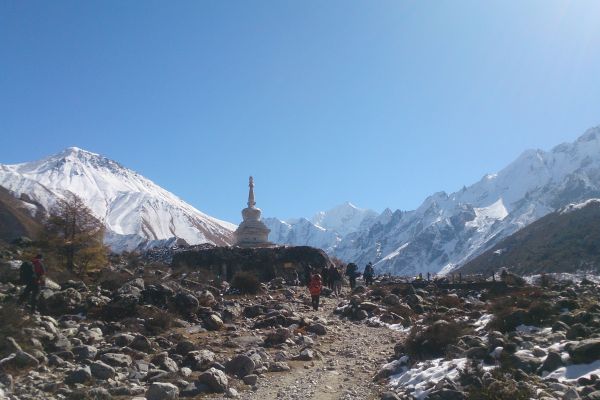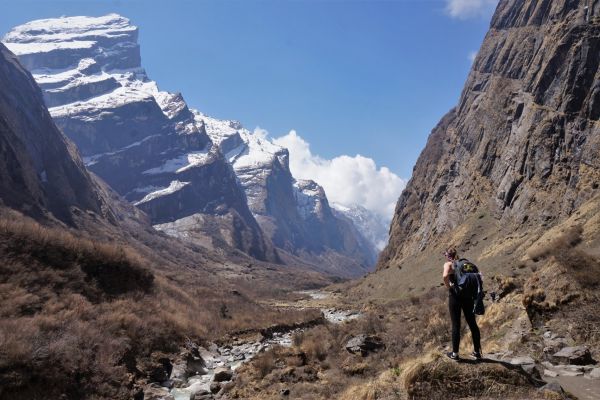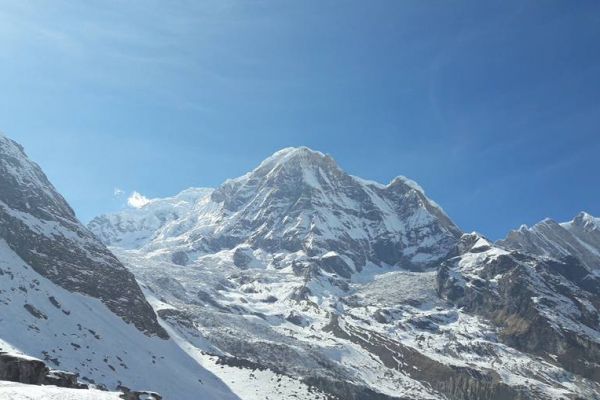- Trip Code : NTEGPT6
- Trip Duration : 10 Days
- Trip Level : Demanding
- Trip Max Altitude : 3500
- Trip Start Location : Kathmandu
- Trip End Location : Pokhara
- Trip Route : Kathmandu-Pokhara-Ghandruk-Poonhill
- Trip Best Season : March-April & August-November
Trip Highlights
- Best Sunrise and Himalayas View, Poonhill.
- One of the Biggest Ghandruk Gurung village and Ulleri Magar Village.
- View of Dhaulagiri (8167M,) Manaslu (8163m,) and Annapurna I (8091m) and others Himalayas.
- Small villages Birethati, Hile, Tikhedhunga, Ghorepani, Tadapani.
- Waterfall, Rice Terrace.
- Easy, Short, and breath-taking trek in the Annapurna region.
Trip Information
The Ghorepani Poon-Hill trek is a short and easy holiday trek in Nepal that takes you to the beautiful surroundings of the Annapurna area. This trek is typically predominant amongst the voyagers and particularly trekkers who are searching for a couple of days to be close to nature and want to experience nearby culture in Nepal without including in high altitude climbs. There is no hazard at all of the high-altitude sicknesses on this trek. Taking the enduring pace through the wonderful Modi waterway valley, you delicately scale to Poon-Hill, which lies at the foot of the Annapurna massif. You will cherish every last-minute locating at awe-inspiring Himalayan Mountain perspectives of Dhaulagiri, Annapurna South(7219m), Machhapuchhre (Fish Tail) (6997m), Manaslu and other snow-capped mountains and experience socially rich multi-ethnic towns along the course of the trek.
From Kathmandu, we drive to Pokhara taking after the Prithvi Highway and the next morning we drive from Pokhara to Nayapul, the trek’s beginning stage. Leaving Nayapul we will stroll along Modi River going through the woodland of rhododendron and reaching up to Tirkhedhunga town. The following day, we move for 2hrs through tough trails. Passing the towns of Ulleri and Banthanti and achieving the highest point of the Nangethanti Hill. At that point, we will descend from Nangethati to Ghorepani and remain for our overnight at the teahouse. After waking up before the break of first light, we’ll climb up to Poon Hill to see a spectacular sunrise over the Himalayan Mountains. From Poon Hill, we stroll down to the teahouse and take breakfast. At that point, we head down to Ghandruk town. This is an extremely prominent customary town of Gurung communities, where you can encounter their deep-rooted traditions and culture. After spending a night at Ghandruk town we will follow the course back to Nayapul and catch land transport. We meet numerous kindred trekkers up and down the route along the trek.
Note:- Above mention information is just the guideline and a standard template of what we provide. The trip can be customized at your request to accommodate your specific requirements.
Short Itinerary
- Day 1 - Arrival day at Kathmandu
- Day 2 - Full day guided sightseeing tour in Kathmandu.
- Day 3 - Kathmandu to Pokhara (910m/2986ft.)
- Day 4 - Pokhara to Tirkhe Dhunga (1577m).
- Day 5 - Tirkhe Dhunga to Ghorepani (2855m).
- Day 6 - Ghorepani to trek Poon Hill (3210m) and to TADAPANI (2630m).
- Day 7 - Tadapani to Ghandruk (1950m).
- Day 8 - Ghandruk to Pokhara (910m).
- Day 9 - Pokhara to Kathmandu
- Day 10 - Final Departure.
- Day 1 Arrival day at Kathmandu
- Day 2 Full day guided sightseeing tour in Kathmandu.
- Day 3 Kathmandu to Pokhara (910m/2986ft.)
- Day 4 Pokhara to Tirkhe Dhunga (1577m).
- Day 5 Tirkhe Dhunga to Ghorepani (2855m).
- Day 6 Ghorepani to trek Poon Hill (3210m) and to TADAPANI (2630m).
- Day 7 Tadapani to Ghandruk (1950m).
- Day 8 Ghandruk to Pokhara (910m).
- Day 9 Pokhara to Kathmandu
- Day 10 Final Departure.
Price Includes
- Airport / Hotel / Airport pick up & drop off service by a private tourist vehicle.
- Standard twin-sharing accommodation in a three-star hotel in Kathmandu including breakfast (2 nights).
- Guesthouse accommodation during the trek in mostly twin-share and occasionally dormitory-style rooms
- All standard meals during the trek ( Breakfasts, Lunches and Dinners).
- Local gov licensed English-speaking trekking guide.
- The required number of local staff and porters to carry your luggage during the trek. We assign one porter for every two guests.
- Food, accommodation, salary, insurance, equipment and medicine for all staff.
- Annapurna Conservation permits and TIMS permit for trekking.
- Ground Transport service from Kathmandu - Pokhara- Kathmandu and Pokhara-Nayapul-Pokhara.
- Free Nepal Travel duffel/kit bag and sun hat (yours to keep).
- All our government taxes, vat, tourist service charges.
- Official expenses.
Price Does not Include
- Lunch and dinner in Kathmandu. Depending on your budget, it may cost about USD 15 to USD 20 per person.
- Travel Insurance(compulsory!), which covers emergency high-altitude rescue and evacuation (See the travel insurance page.)
- International airfare and airport departure tax (See the international flights page.)
- Nepal entry visa - You can obtain the visa easily upon your arrival Airport in Kathmandu
- Tourist Visa with Multiple Entries for 15 days can be obtained by paying USD 25 or equivalent foreign currency.
- Similarly, Tourist Visa with Multiple Entries for 30 days and 90 days can be obtained by paying USD 40 and 100 respectively. Please bring 2 copies of passport size photos.)
- Alcoholic, hot and cold drinks.
- Personal trekking equipment.
- Tips for trekking staff and driver (tipping is expected).
- Any others expenses that are not mentioned in the 'Price Includes' section.
Trekking equipment and clothing needed for this trek
- Warm fleece hat with ears cover or balaclava.
- Sun hat and scarf to cover face.
- Good polarized sunglass (uv protector).
- Cold proof polypropylene tshirt (2/2 half and full sleeve).
- Wind proof fleece jacket and thermal down tshirt.
- Waterproof shell jacket and Gore-tex jacket.
- Light weight poly-liner gloves and wool or fleece gloves(1 pair each).
- A pair of expedition mittens.(waterproof shell).
- Underwears.
- Light weight cotton pants and hiking shorts.(1 pair each)
- A pair of light and expedition thermal bottoms.
- A pair of fleece trousers and A pair of waterproof shell pants.(breathable fabric)
- A pair of socks.(Thin lightweight inner and thick warm wool hiking socks).
- Hiking shoes with spare laces.
- Light sandals/shoes for camp.
- Headlamp (with extra battries and bulbs)
- Basic First Aid Kit
- Large plastic bags.
- 2 water bottles.(1 liter each)
- Toiletries and Medium size towel.
- Face and body moisturizer
- 1 medium rucksack (50-70 liters/3000-4500 cubic inches)
- A small day trek bag( with combination lock).
- Small padlocks for duffel bags.
- Books, Games, Binoculars. (Optional).
The price per person for the Small group Journey is fixed as stated below. There is also the option of private and tailor made journey best suited for you, your family and friends. The discount is subjected to increase with the number of people in your group. Bigger the group better the discount so group bookings are highly encouraged.
Frequently Asked Questions
- All your departure is guaranteed to run?
- Do I need to tip my guide and porters? How much would that be?
- Can I add extra days to my trek or trip?
- Do you use Yaks and porters on the trek or do we carry all of our own gear?
- Will there be a place to store items clothing not require for the trek?
- Can I charge my digital camera, mobile or other equipment on my trip?
- Is there any communication while we are on trekking?
- Do you guys have a PAC portable altitude chamber?
- If I am sick can I continue the trek next day after a day rest?
- What if I am badly sick in the Mountain?
- Is Nepal Travel Expedition staff insured?
- What safety measures are in place? What safety equipment do your guides carry with them on the trek to deal with altitude sickness/accident?
- Do your guide have trekking guide certificate from the government tourism center? Have they received first aid training for high altitude?
- What is the weather and temperature like in trekking?
- What is the best session for this trekking?
- What is your cancellation policy?
- Is it possible to reserve a trip now pay deposit later or do I have to pay deposit at booking reservation?
- Do we book own international flights to and from Nepal?
- What mode of transportation do you use?
- How much additional money do I need per day for the trek?
- What are the opportunity will I have for the shower along the trek?
- What is the drinking water facilities in the mountain?
- If I am vegetarian, is that a problem?
- Is the food in mountain prepare to international standard in terms of safety?
- What are the Toilet facilities in the tea house or guest house in the trekking route?
- What short of accommodation can I expect in Kathmandu and in the trekking?
- What types of extra document do I need?
- Can I obtain visa for Nepal upon on arrival at airport?
- Will somebody come to pick me up at the airport upon my arrival?
- What types of Shape do I need to be in this trip?
Note:- Above mention information is just the guide line and a standard template of what we provide. The trip can be customize at your request to accommodate your specific require programmed the timeframe for the trip.
Trip Note:- During the trip you might face different different problems such as weather, local politics , transport or a multitude of other factor that are beyond our control could bring change in the programmed. However every unlikely that the itinerary would be substantially atered, if alternative way is necessary, then the tour leader will take decision that the best alternative option. We try to make understand everything clear that we can to minimize its effect but we can not ensure unseen result of changes or delays.
Why this trip make different?
Nepal Travel Expedition works closely with One of the main supporter's Charity service in Nepal. And contribute 10% of the tour cost for Orphan Childrens (sherpa Outdoor Foundation) We support them in many different ways.
Donation and Charity!
Nepal Travel Expedition donates 10% of its annual revenue to Sherpa Outdoor Foundation Orphan Children Home Which is Located in Lalitpur one can visit while you are in Nepal after or before the trip. We support Children's for Food, School, Clothes, Medicine also supporting stationery materials to Government School which is located at Lamjung district trying to build a library for them where they could find a different book to read. For this project, we are trying to collect donations.
Sponsorship and Partnership (volunteering programmed)
One of the major activities of Sherpa outdoor Children home in Lalitpur is fully conducted and collaborate with Nepal Travel Expedition and sister concern organization Nepal wildlife safari. The Volunteering concern programmed delivered by Nepal Travel Expedition and Sherpa Outdoor Foundation aims to mobilize a team of experts and interested individuals as an economic measure in providing human capital for education, health, community to share teaching skill various Government school in a different part of the country and community to delivered humanity skills also in our children home.






